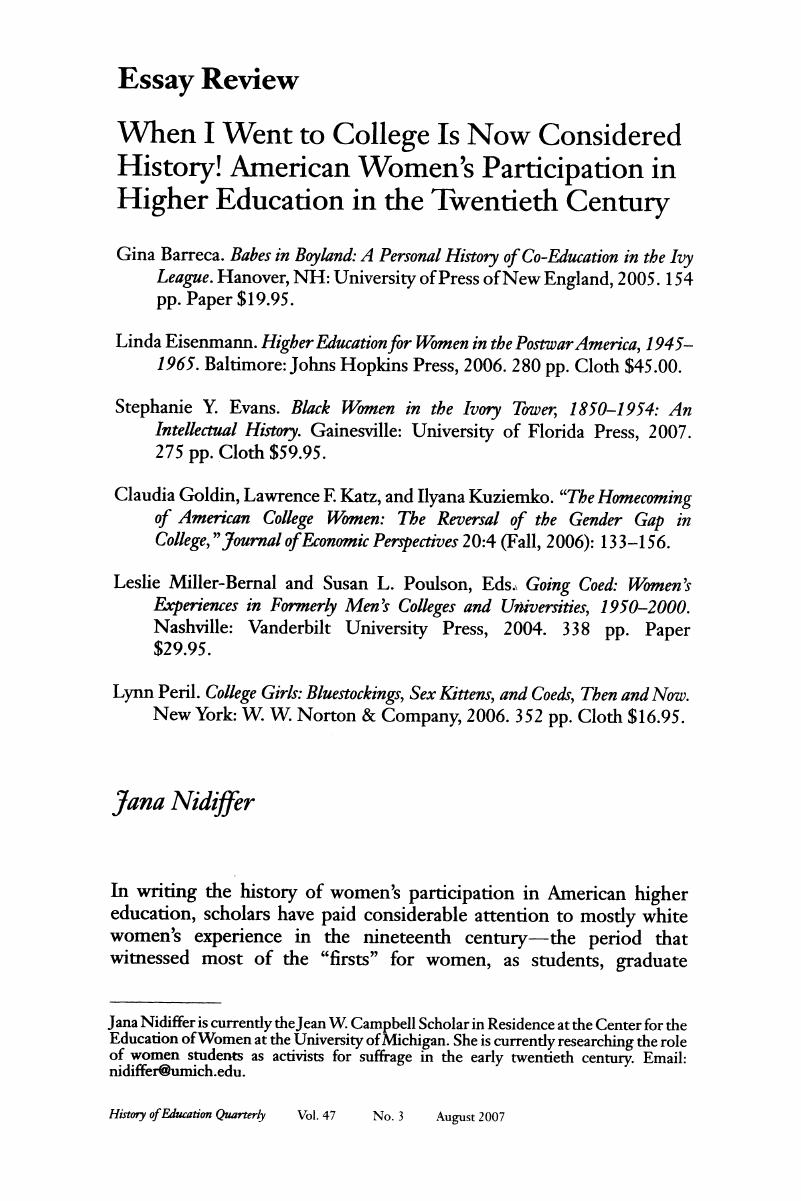No CrossRef data available.
Published online by Cambridge University Press: 24 February 2017

1 Published as: Zook, George F., Higher Education for American Democracy: A Report of the President's Commission on Higher Education, Vols. I-VI (New York: Harper & Brothers, 1947). This document was colloquially known as the Truman Report.Google Scholar
2 Ibid., Vol. I, 38.Google Scholar
3 Ibid., Vol. II, 39-40.Google Scholar
4 Noble, Jeanne L., The Negro Woman's College Education (New York: Teachers College, 1956).Google Scholar
5 As this book is not yet published at the time of the submission of this review, but will be soon, galley pages were used so there is a slight chance that page numbers in the finished book could be slightly different.Google Scholar
6 Radcliffe College no longer exists, per se, but is now the Radcliffe Institute for Advanced Study.Google Scholar
7 Barreca, Regina, They Used to Call Me Snow White—But I Drifted: Women's Strategic Use of Humor (New York: Viking, 1991).Google Scholar
8 Felix culpa is Latin for “happy fault” or “fortunate fall”; a religious term referring Adam and Eve's fall and the loss of the Garden of Eden.Google Scholar
9 For general histories of higher education, they used Frederick Rudolph, The American College and University: A History (New York: Knopf, Alfred A., 1962) and the less dated, but unremarkable, Christopher Lucas, J., American Higher Education: A History (New York: St. Martin's Press, 1994), instead of the newer and more comprehensive, Thelin, John R., A History of American Higher Education (Baltimore: Johns Hopkins University Press, 2004). For background information on women's educational history, the most cited volumes were: Horowitz, Helen Lefkowitz, Alma Mater: Design and Experience in the Women's Colleges from their Nineteenth-Century Beginnings to the 1930s (New York: Knopf, 1984); Kerber, Linda K., Women of the Republic: Intellect and Ideology in Revolutionary America (Chapel Hill: Published for the Institute of Early American History and Culture by the University of North Carolina Press, 1980); and Solomon, Barbara M., In the Company of Educated Women: A History of Women and Higher Education in America (New Haven, CT: Yale University Press, 1985).Google Scholar
10 An interesting study on this topic is, Holland, Dorothy C. and Eisenhart, Margaret A., Educated in Romance: Women, Achievement, and College Culture (Chicago: University of Chicago Press, 1990).Google Scholar
11 Malkmus, Doris J., “Nineteenth-Century Coeds and the Value of an ‘Identified’ Life,” Perspectives on the History of Higher Education 25 (2006): 145-155.Google Scholar
12 First coined in 1982 by Bernice (Bunny) Sandler, R. and Hall, Roberta, the term “chilly climate” meant that the environment for women in college classrooms was not as warm and welcoming as the environment for men. The most recent iteration of this research illustrated that things were not much better by the mid-1990s. See Sandler, Bernice R., Silverberg, Lisa A., and Hall, Roberta H., eds., The Chilly Classroom Climate: A Guide to Improve the Education of Women (Washington, DC: National Association for Women in Education, 1996).Google Scholar
13 Jaschik, Scott, “What Harvard's Choice Means,” Inside Higher Ed Electronic Newsletter. Retrieved on 2/12/2007 at: http://insidehighered.com/news/2007/02/12/harvard.Google Scholar
14 See footnote #7 for a list of the works most commonly cited. The academy movement is discussed thoroughly, for example in Beadie, Nancy and Tolley, Kim, eds., Chartered Schools: Two Hundred Years of Independent Academies in the United States, 1727-1925 (New York: RoutledgeFalmer, 2002).Google Scholar